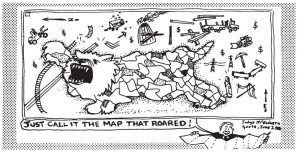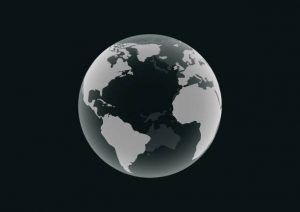“Write a blog that hyper-links your research on the characters in GGRW using at least 10 pages of the text of your choice. Be sure to make use of Jane Flicks’ GGRW reading notes on your reading list.”

From Mirror News online
Pages 414 – 424, 1993 edition.
King is the master of hidden references (hidden, that is, if you don’t attempt to decipher them). As Fee and Flick point out, Green Grass Running Water arouses the readers desire to understand the allusions, jokes, and unanswered questions throughout the novel. King combines several networks of cultural knowledge within his story, expecting that every reader is familiar with at least one of the networks, allowing them to cross the borders between what they know and don’t know through analogy – training the reader in Coyote pedagogy (Fee & Flick, 131).
Within the last section of the novel, there are many “jokes” and allusions to cultural references that even my familiar network of knowledge could not help me decipher without the help of Flick. Several references in particular impressed me once I began to understand their meaning.
A Nissan, Pinto, and Karmann-Ghia
The first name mentioned within my chosen pages is Clifford Sifton, the character in the book responsible for the dam. It is thought by Flick that this is a reference to the real Sir Clifford Sifton, who ultimately was a promoter of aggressive settlement of Alberta and a supporter of the displacement of indigenous populations so their land could be obtained for Western settlement.
The three missing cars are then seen by Sifton and a colleague to be floating on Parliament Lake, heading towards Sifton’s dam. According to Flick, the three cars are potentially a reference to the three ships – the Niña, Pinta, and the Santa Maria – which were sponsored by Isabella of Spain to sail with Columbus on his voyage to the West Indies. Instead, however, he landed upon North and South America and is now often credited with their “discovery”. The cars are then thrown into the dam by Coyote’s earthquake, and the dam fractures. At this point, King states that “the water and the cars tumbled over the edge of the world” (King, 414), referencing the flat earth theory that has been (falsely) attributed to early explorers, such as those in Columbus’s day.
Columbus initially led the way for European colonization of the Americas, and Sifton only further promoted it within Canada. The dam built by Clifford Sifton (the character) could be a representation of the promotion of European colonization of Alberta and the lack of regard of the Blackfoot’s traditional territory. Through its destruction by the cars, Sifton and Columbus’s colonial narratives are also brought down by Coyote, an Indigenous narrative, and Indigenous treaty rights are reasserted.
Bill Bursum is also present in this section of the text. Like Sifton, King based Bursum from two real historical figures: Holm O. Bursum and his Bursum Bill of 1921, as well as William F. Cody. The Bursum Bill of 1921 was proposed to give land and water rights to non-indigenous settlers of Pueblo lands, stripping the Pueblo people of large portions of their traditional territory in New Mexico. The “Bill” portion of Bill Bursum also could refer to William F. “Buffalo Bill” Cody, who exploited Native American peoples in the name of entertainment. In the story, Bill Bursum purchased lakeside property, essentially claiming land that was not his, and also using the exploitation of the Indigenous land for economic benefit.
Coyote the Trickster
Coyote also has a large role in this section of the story. According to Flick, Coyote is a familiar trickster figure within the traditional oral literature of Indigenous peoples in North America. Tricksters have tremendous powers, creating the world, human life, and human culture, but were also associated with being rule-breakers who crossed borders and ignored social harmony and order (The Canadian Encyclopedia). In this section of the story, Coyote starts an earthquake which eventually causes the destruction of the dam. The 4 old Indians begin to chastise him for fooling around, Robinson Crusoe specifically mentioning “the last time [Coyote] fooled around like this…the world got very wet” (King 416). This statement is potentially implying that, rather than God causing Noah’s flood, it had been Coyote. Coyote also tries to argue that he had been helpful in the past, as shown in the following passage:
“But I was helpful too,” says Coyote. “That woman who wanted a baby. Now, that was helpful.”
“Helpful!” said Robinson Crusoe. “You rememberthat last time you did that?”
“I’m quite sure I was in Kamloops,” says Coyote.
“We haven’t straigtened out that mess yet,” said Hawkeye.
(King, 416)
In the first line, Coyote is taking claim for Alberta’s pregnancy. Robinson Crusoe’s statement is referencing the immaculate conception of Jesus in Mary, yet again implying that rather than God’s actions creating the birth of Jesus, it had actually been Coyote. Likewise, the last statement made by Hawkeye is suggested by Flick to be referencing the creation of Christianity (through the birth of Jesus). The tone of the statement inferences that Christianity was the problem that resulted from Coyote’s mistake in impregnating Mary, again breaking down a generally Western, colonial narrative.
References:
Fee, Margery, and Jane Flick. “Coyote Pedagogy”. Canadian Literature 131 -139. (1999). Web. http://canlit.ca/canlitmedia/canlit.ca/pdfs/articles/canlit161-162-Coyote(FeeFlick).pdf. Accessed 17 Mar. 2019.
Flick, Jane. “Reading Notes for Thomas King’s Green Grass Running Water.” Canadian Literature 161-162. (1999). Web. 17 Mar. 2019.
Hall, David. “Sir Clifford Sifton”. The Canadian Encyclopedia. 5 April 2018. Web. https://www.thecanadianencyclopedia.ca/en/article/sir-clifford-sifton. Accessed 17 Mar. 2019.
King, Thomas. Green Grass Running Water. Toronto: Harper Collins, 1993.
Martinez, Matthew. “All Indian Pueblo Council and the Bursum Bill”. NewMexicoHistory.org. Web. http://newmexicohistory.org/people/all-indian-pueblo-council-and-the-bursum-bill. Accessed 17 Mar. 2019.
Pritchard, Heledd. “How did this car end up submerged in a lake in a country park?” Mirror. 17 Aug. 2015. Web. https://www.mirror.co.uk/news/weird-news/how-car-end-up-submerged-6270762. Accessed 18 Mar. 2019.
Robinson, Amanda. “Trickster”. The Canadian Encyclopedia. 5 April 2019. Web. https://www.thecanadianencyclopedia.ca/en/article/trickster. Accessed 8 Mar. 2019.
“William F. Cody”. PBS. Web. https://www.pbs.org/weta/thewest/people/a_c/buffalobill.htm. Accessed 17 Mar. 2019.





